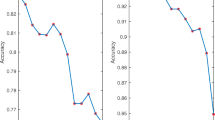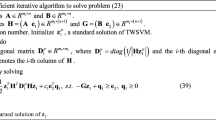Abstract
Twin support vector machine (TWSVM) is an efficient supervised learning algorithm, proposed for the classification problems. Motivated by its success, we propose Tree-based localized fuzzy twin support vector clustering (Tree-TWSVC). Tree-TWSVC is a novel clustering algorithm that builds the cluster model as a binary tree, where each node comprises of proposed TWSVM-based classifier, termed as localized fuzzy TWSVM (LF-TWSVM). The proposed clustering algorithm Tree-TWSVC has efficient learning time, achieved due to the tree structure and the formulation that leads to solving a series of systems of linear equations. Tree-TWSVC delivers good clustering accuracy because of the square loss function and it uses nearest neighbour graph based initialization method. The proposed algorithm restricts the cluster hyperplane from extending indefinitely by using cluster prototype, which further improves its accuracy. It can efficiently handle large datasets and outperforms other TWSVM-based clustering methods. In this work, we propose two implementations of Tree-TWSVC: Binary Tree-TWSVC and One-against-all Tree-TWSVC. To prove the efficacy of the proposed method, experiments are performed on a number of benchmark UCI datasets. We have also given the application of Tree-TWSVC as an image segmentation tool.





Similar content being viewed by others
References
Vapnik VN (1999) An overview of statistical learning theory. IEEE Trans Neural Networks 10(5):988–999
Jayadeva, Khemchandani R, Chandra S (2007) Twin support vector machines for pattern classification. IEEE Trans Pattern Anal Mach Intell 29(5):905–910
Khemchandani R (2008) Mathematical programming applications in machine learning, Ph.D. dissertation. Indian Institute of Technology Delhi New Delhi-110016, India
Kumar MA, Gopal M (2009) Least squares twin support vector machines for pattern classification. Expert Syst Appl 36(4):7535–7543
Sartakhti JS, Ghadiri N, Afrabandpey H (2015) Fuzzy least squares twin support vector machines. arXiv:1505.05451
Tanveer M, Khan MA, Ho SS (2016) Robust energy-based least squares twin support vector machines. Appl Intell:1–13
Shao YH, Wang Z, Chen WJ, Deng NY (2013) Least squares twin parametric-margin support vector machine for classification. Appl Intell 39(3):451–464
Khemchandani R, Pal A (2016) Multi-category laplacian least squares twin support vector machine. Appl Intell 45(2):458–474
Hastie T, Tibshirani R, Friedman J (2009) Unsupervised learning. Springer
Jain AK (2010) Data clustering: 50 years beyond k-means. Pattern Recogn Lett 31(8):651–666
Jain AK, Dubes RC (1998) Algorithms for clustering data. Prentice-Hall Inc.
Ng AY, Michael IJ, Yair W (2002) On spectral clustering: Analysis and an algorithm. Adv Neural Inf Proces Syst:849–856
Shi J, Malik J (2000) Normalized cuts and image segmentation. IEEE Trans Pattern Anal Mach Intell 22 (8):888–905
Wu W, Xiong H, Shekhar S (eds.) (2013) Clustering and information retrieval (Vol. 11) Springer Science and Business Media
Moon TK (1996) The expectation-maximization algorithm. IEEE Signal Process Mag 13(6):47–60
Al-Harbi SH, Rayward-Smith VJ (2006) Adapting k-means for supervised clustering. Appl Intell 24 (3):219–226
Bradley PS, Mangasarian OL (2000) k-plane clustering. J Global Optim 16(1):23–32
Yang ZM, Guo YR, Li CN, Shao YH (2015) Local k-proximal plane clustering. Neural Comput & Applic 26(1):199–211
Xu L, Neufeld J, Larson B, Schuurmans D (2004) Maximum margin clustering. Adv Neural Inf Proces Syst 17:1537–1544
Valizadegan H, Jin R (2006) Generalized maximum margin clustering and unsupervised kernel learning. Adv Neural Inf Proces Syst:1417–1424
Boyd S, Vandenberghe L (2004) Convex Optimization. Cambridge university press
Lobo MS, Vandenberghe L, Boyd S (1998) Applications of second-order cone programming. Linear Algebra Appl 284(1):193–228
Zhang K, Tsang IW, Kwok JT (2009) Maximum margin clustering made practical. IEEE Trans Neural Networks 20(4):583–596
Wang Z, Shao YH, Bai L, Deng NY (2015) Twin support vector machine for clustering. IEEE Transactions Neural Networks and Learning Systems 26(10):2583–2588
Hsu CW, Lin CJ (2002) A comparison of methods for multiclass support vector machines. IEEE Trans Neural Networks 13(2):415–425
Khemchandani R, Pal A (2016) Fuzzy least squares twin support vector clustering. Accepted by Neural computing and applications
Mangasarian OL (1993) Nonlinear programming. SIAM 10
Yuille AL, Rangarajan A (2003) The concave-convex procedure. Neural Comput 15(4):915–936
Smola AJ, Schol̇kopf B (1998) Learning with kernels. Citeseer
Suykens JAK, Vandewalle J (1999) Least squares support vector machine classifiers. Neural Process Lett 9(3):293–300
Gunn SR (1998) Support vector machines for classification and regression. ISIS technical report 14
Larose DT (2005) k-nearest neighbor algorithm. Discovering Knowledge in Data: An Introduction to Data Mining: 90-106
Huttenlocher DP, Klanderman GA, Rucklidge WJ (1993) Comparing images using the hausdorff distance. IEEE Trans Pattern Anal Mach Intell 15(9):850–863
Cormen TH (2009) Introduction to algorithms. MIT press
Wang X, Wang Y, Wang L (2004) Improving fuzzy c-means clustering based on feature-weight learning. Pattern Recogn Lett 25(10):1123–1132
Blake C, Merz CJ (1998) Uci repository of machine learning databases. Available: www.ics.uci.edu
Hsu CW, Chang CC, Lin CJ (2003) A practical guide to support vector classification
Tan PN, Steinbach m, Kumar V (2005) Introduction to data mining. Addison-Wesley
Alzate C, Suykens JAK (2010) Multiway spectral clustering with out-of-sample extensions through weighted kernel PCA. IEEE Trans Pattern Anal Mach Intell 32(2):335–347
Alzate C, Suykens JAK (2011) Out-of-sample eigenvectors in kernel spectral clustering. In: The 2011 International Joint Conference on Neural Networks (IJCNN). IEEE, pp 2349–2356
Arbelaez P, Fowlkes C, Martin D (2007) The berkeley segmentation dataset and benchmark. http://www.eecs.berkeley.edu/Research/Projects/CS/vision/bsds
Khan JF, Adhami RR, Bhuiyan SM (2009) A customized gabor filter for unsupervised color image segmentation. Image Vis Comput 27(4):489–501
Mehrkanoon S, Alzate C, Mall R, Langone R, Suykens JAK (2015) Multiclass semi-supervised learning based upon kernel spectral clustering. IEEE Transactions on Neural Networks and Learning Systems 26 (4):720–733
Acknowledgments
We would like to take this opportunity to thank Dr.Suresh Chandra, for his guidance and constant encouragement throughout the preparation of the manuscript.
Author information
Authors and Affiliations
Corresponding author
Appendix A: Loss function of TWSVM
Appendix A: Loss function of TWSVM
TWSVM uses hinge loss function which is given by
\(L_{h}=\left \{ \begin {array}{ll} 0, & y_{i}f_{i} \geq 1 \\ 1-y_{i}f_{i}, & otherwise \end {array} \right . \)
For any SVM or TWSVM based clustering method, the clustering error or the hyperplanes change little after initial labeling or during subsequent iterations. This arises due to hinge loss function, as shown in Fig. 6a, where the classifier tries to push y i f i to the point beyond y i f i =1 (towards right) [23]. Here, solid line shows loss with initial labels and dotted line shows loss after flipping of labels. As observed from the empirical margin distribution of y i f i , most of the patterns have margins y i f i ≫1. If the label of a pattern is changed, the loss will be very large and the classifier is unwilling to flip the class labels. So, the procedure gets stuck in a local optimum and adheres to the initial label estimates. To prevent the premature convergence of the iterative procedure, the loss function is changed to square loss and is given as L s =(1−y i f i )2. This loss function is symmetric around y i f i =1, as shown in Fig. 6b and penalizes preliminary wrong predictions. Therefore, it permits flipping of labels if needed and leads to a significant improvement in the clustering performance.
Rights and permissions
About this article
Cite this article
Rastogi, R., Saigal, P. Tree-based localized fuzzy twin support vector clustering with square loss function. Appl Intell 47, 96–113 (2017). https://doi.org/10.1007/s10489-016-0886-8
Published:
Issue Date:
DOI: https://doi.org/10.1007/s10489-016-0886-8





